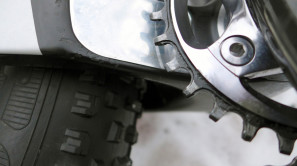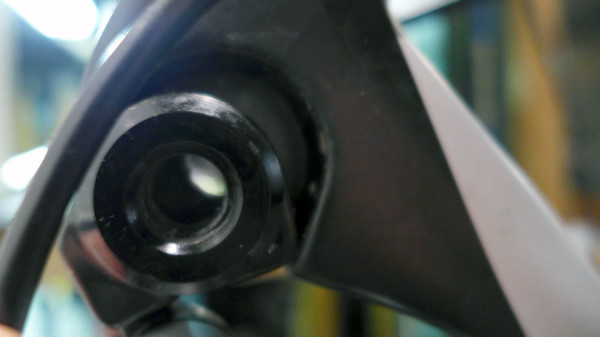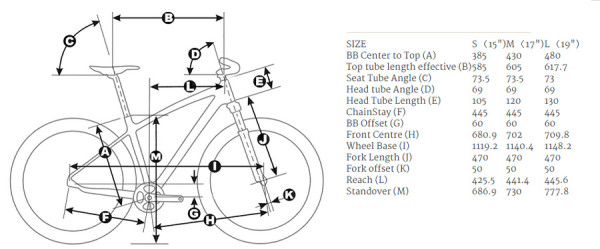
Sarma Bikes floated into the world of fat bikes last year with one of the first carbon fiber rims for the wide tired machines, the double-walled, 80mm wide Naran. Over the course of only a year, they have grown to offer a 100mm wide rim, 29+ rim, carbon fork, fat bike hubs, and the Shaman complete carbon fiber bike.
This season, Sarma has a Michigan-based US distributor, but the company is based in Hong Kong. We connected with them recently to test the top of the line Shaman XX1, complete with Hoboy fork, Naran 80 rims, and full SRAM XX1 drivetrain.
Weighing in at just over 23lbs, it is impressively light for a fat bike. A ride like this doesn’t come without a price though. Are the impressive results worth the cost?

Ride
Jumping on the Sarma Shaman, the most immediate reaction is how light it feels to pedal. At 23lbs, 3oz, it would actually qualify as the lightest bike in my garage, coming in with less mass than my gravel bike with 35c tires. The low weight, and capability of the fat tires, makes it feel extremely capable.

Since the Shaman is aimed at having all of the best components, the low weight comes with no sacrifices other than your check account balance. The frame stays very solid through cornering, more than expected for a 1250g frame. The wheels remain laterally stiff no matter how hard they are pushed, and the through-axles keep it all tied together tightly. Pushing the bike hard, and looking for fault, there was nothing negative to say about the performance of the Shaman on the trail.


Frame Construction & Build Specs
Being that Sarma was so quick to market with the Shaman, I half expected some cut corners. Surprisingly, none were found and it exceeded expectations, and the frame was very well constructed throughout. The frame features internal cable routing with replaceable inserts, a stainless steel strike plate on the chainstay, and alloy inserts for the bottom bracket threads.
Built with high modulus carbon fiber, the Shaman felt very solid when riding, with no hints of flex. The fork appears to be much more svelte than rest of the bike, which was good for absorbing what impacts the tires didn’t devour, yet it held the intended line.
The overall build kit is a mix of top-shelf XX1 components and Sarma-branded parts. Typically, cockpit parts that are branded by the company of the bike can be a place to save cost and increase margin for a brand, but the Sarma cockpit is very nice. The handlebar is especially nice, being full carbon, and uniquely width-specific for each size of bike. The Sarma-branded hubs also felt very smooth, with the rear having a seemingly high amount of engagement points (and a nice loud buzz) typically found on higher end hubs. One note is that Sarma says the bike will come with a Sarma-branded crank with 1x 28t ring, but our test bike came with Sram XX1 carbon cranks with 28t ring.

SPECS-
- Frame – Sarma Shaman
- Fork – Sarma Hoboy /Rock Shox Bluto (80mm, Diffusion Black, Remote (PushLoc))
- Stem – Truvativ Stylo t30 75mm/90mm/100mm (S/M/L sizes)
- Seatpost – Sarma, carbon 400mm
- Saddle – WTB Silverado Race SL Black, 255g
- Handlebar – Sarma (carbon) 720mm/740mm/760mm (S/M/L sizes)
- Grips – Propalm
- CrankSet – Sarma 1×11 w/ 28t chainring
- Chain – SRAM XX1
- Rear Derailleur- SRAM XX1
- Cassette – SRAM XX1
- Shifter- SRAM XX1
- Brakes – Avid XX
- Hubs – Sarma 135&170mm
- Spokes/Nipples – DT Revolution
- Rims – Sarma Naran 80
- Tires – Vee Tire Co. H-Billie


Design
It is quite obvious that Sarma placed a good amount of time investment into the industrial design of the frame. The fork has a variety of interesting shapes and lines, and the downtube of the frame was well balanced with the visual weight of the wheels. As a complete bike, it looks nice and normal, even though the down tube measures an amazing 87mm in width. On any regular bike, this would be freakishly large, but on a bike with 4″ tires, it makes everything look proper.
With a 170mm dropout spacing and 100mm wide bottom bracket shell, the Shaman is designed for 4″ tires. yet the frame and drivetrain provided ample clearance for the 4.25″ wide Vee Tire Co. H Billie tires. The rear hub spacing is hard for me to figure out. Rather than stick with one of the established standards, they created 170mm through-axle, with hub catches. This amounts to the equivalent of a 163mm wide QR hub, which also throws off the chainline, since the SRAM XX1 crank was designed for the 170mm QR chainline. Additionally, that means no other hub besides the Sarma-branded hub can be used on this bike, since nobody else has used these dimensions.
One annoying niggle was in the Hoboy Carbon fork. The fork is designed around a 135mm hub spacing and a 15mm through-axle. Sarma did not add recessed hub catches on the fork, so the wheel has nothing to anchor on until the axle is in place. This makes installing and removing the front wheel an exercise in aligning two moving targets, and can be frustrating.

One really strange thing was that the axle was the primary thing holding the der hanger in place. There was a small screw as well so it didn’t totally fall off, but if you removed the axle, the hanger would move, making axle re installation now require jugging the derailleur around as well to get it all to work.

Geometry
The bike handled very well. On paper, it looks like more of the modern bikes, using a 69 degree head tube angle and a 50mm offset on the fork. It could have been weight distribution, but the bike felt heavy in the steering, similar to an older geometry like a Pugsley. The size large test bike arrived with a 110mm stem, putting the rider quite a bit over the front, so the stem was changed out to a 90mm. The heavier feeling steering still existed though, even after changing the rider position by also adding a lay-back seatpost.

Despite the feeling of the front end, the rest of the bike was comfortable and stable. At 445mm long, the chainstays are shorter than a lot of other fat bikes, yet the front end remained on the ground, and the rear tire had traction, even climbing up steep hills covered in sugary, granular snow. Given the often wet, slippery conditions fat bikes are ridden on, chainstay length is a particularly important balance of handling and traction, and Sarma found a sweet spot.
Findings
At $5,900, the Shaman does not come cheap. But a 23lb fat bike requires a lot of high end parts and expensive materials to get to that impressive weight. When you factor in getting a full XX1 drivetrain, carbon fiber rims, full carbon cockpit, and full carbon frame and fork for that price, Sarma’s flagship bike is a pretty good deal. I felt that as a first-year product, it did well, but maybe not as polished as more established brands. Small details such as the missing front hub catches, the strange rear spacing, and a der hanger that moves when the axle is out of the bike are the little annoying things that a larger brand typically has figured out. $5,900 is a good price for all the high-end features included, but for a high-end ride that costs as much as a good used car, I would expect perfection.

We will continue riding the Shaman throughout the winter, and report back with a long term test after we have put it through the paces.